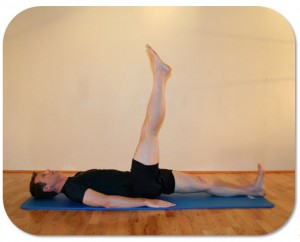How to Hold the Hips Still On the One Leg Circle Exercise in Pilates Matwork
Use these helpful Pilates Fitness Tips to improve your exercise technique for the Pilates One Leg Circle exercise in Matwork.
There are quite a few different variations and modifications for each of the Pilates Exercises. Any change to an exercise has value, it just shifts the focus to help you find & feel different things that need your attention. Different is not good or bad, just different. It might depend on what your goals are for the workout, or what parts of your body need to become stronger or more flexible that is the deciding factor for any exercise you do.
Thinking about variations for the basic version of the One Leg Circle in Pilates Matwork, there are many ways that this exercise can be tweaked to help improve body awareness, muscle support, and technique.
The basic Pilates One Leg Circle is executed by keeping the back & pelvis still on the mat and circling the leg only.
Here are a couple of questions to ask to determine the appropriate starting version of the One Leg Circle exercise:
- What is your level of experience with the Pilates Mat Exercises.
- Do you have weak abs?
- Do you have a tight low back, or lower back problems?
- Do you have tight hamstrings?
- Do you have tight hip flexors?
For Beginners My Favorite One Leg Circle Options Are:
- Keeping the lifted leg straight, and the supporting leg bent with the foot on the floor.
- Using a strap or towel to help support the lifted leg while circling. (Bottom leg bent progressing to straight) Helps keep the Quads & hip flexors relaxed, to focus on Abs & Psoas lifting the leg.
- Using 1-Leg Spring on the Pilates Cadillac or Tower. This helps support the leg without using the arms & shoulders. Also provides resistance through the bottom of the circle to strengthen the back of the leg while better supporting the torso.
- Hovering the arms in the 100”s position an inch off the mat to help learn how to use your abs a little more & arms less for pelvic stability. (progressing towards Intermediate)
- Holding a Magic Circle or ball with the arms lifted straight up to the ceiling while circling the leg. Again, can’t use the arms & shoulders to do the supporting. Helps find more belly support!
For any of these basic variations, the leg circle is relatively small. Only as big as the pelvis can stay still on the mat. Pelvis still means the tailbone/pubic bone, hips, sacrum, and lower back don’t wiggle. The ribcage and shoulders should remain still too.
Think about the shape of the circle more like a capitol “D” shape than an actual circle. The leg comes straight across the body, does a ½ circle to the opposite side, then lifts back to the starting point, straight up to the ceiling. Doing a D version instead of true circle assists to stretch the outer hips more and helps avoid using the low back to hike a hip up when lifting the leg. Done well your “Pilates Box” (hips & shoulders) will stay square & even on the mat for the whole exercise. (If one hip hikes up – it is impossible to have an even pelvis and swing safely through the bottom of the circle.)
How Do I Keep the Hips & Pelvis Still While Circling the Leg?
It took me a long time in my Pilates practice & teaching career to discover and apply the principle of oppositional support to the One Leg Circle. If this is a new concept to you too – I hope it speeds up the learning curve for you and your students to find and utilize more of the right muscles to hold the pelvis & spine still while swinging the leg.
Our body is a system of levers & pulleys. When we’re moving any part of the body some muscles have to work & others release. For the One Leg Circle – to hold our hips sacrum, and low spine still we have to think about using one side of the abdominals (Obliques to support the standing leg) and the opposite side of the lower back (to support the swinging leg.) If the back is not actively engaged to keep the spine still, the hips and pelvis will rotate with the leg as it opens away from the body. Basically you’re using the muscles that rotate the spine to keep the spine from twisting with the leg as the leg circles away from the body.
A lot of emphasis gets placed on using the abdominals to hold the body still while circling the leg. This is only HALF of what needs to be supporting you. Utilizing the back muscles along with the abs will successfully stabilize the front and back of the torso making it easier to swing the leg and keep the body still.
How to execute the Basic Version of the Pilates One-Leg Circle Exercise:
Focus on a D-shaped circle for the leg. (Right Leg Up to Circle)
- Inhale to take the right leg straight across the body, keeping both hips firmly on the mat. Right leg across helps activate the left side of the Abdominals to keep the left side of the back on the mat.
- Exhale and circle the leg around and down through the bottom of the D. Both hips and shoulders should be evenly weighted on the mat.
- Continue the exhale and keep the Obliques on the left pulling up, in, and back, while activating the spine rotators on the right side of the back (pushing up to hold the spine still) while circling the leg away from the body.
- Inhale and lift the leg back up to the ceiling/starting position.
This whole process works in reverse as you change to circle the right leg in the opposite direction.
- Inhale to pull the abs in and back to the mat keeping the hips still while the leg opens away from the body. (Obliques on the left side in the front of the body / Spine rotators in the back on the right side of the body to hold the pelvis still.)
- Exhale as the leg makes a ½ circles down & across the body. Obliques and spine rotators stabilize the torso against the momentum of the swinging leg.
- Inhale maintain front & back of torso support as leg returns to start position straight up to the ceiling.
My Hips Pop When I Do Leg Circles – It Doesn’t Hurt, But What Can I Do To Fix It?
Ideally the leg that is circling is reaching away from the body to open the hip joint and allow free movement of the leg. If the hip is popping, start with a smaller circle, activate the pelvic floor more, and strive to really reach the leg away from a strong center and see if this combination of things helps to solve the clicking hip issues.
Is the Front of Your Thigh Gripped Or Relaxed When Circling & Lifting the Leg?
Most people tend to lift the leg by pulling the front of the leg up. This lifts the leg using your Rectus Femoris muscle which is one of the four Quadriceps muscles and a hip flexor. While it works to move your leg, using this muscle as the prime lifter only jams your hip into the socket, restricts free leg movement, and will have your Quads working harder than your Abs & Back.
Strive to lift the leg with your Psoas as the hip flexor and keep your Quads more relaxed. This means you’ll notice your lower back elongate, and the leg lifts from underneath up the back of the leg instead of gripping in the front.
- Using a towel, strap, or 1 leg spring on the Cadillac as a variation can help you feel the difference between gripping and hinging to circle and lift the leg.
- You can also try keeping the knee a little bent for awhile to keep the Quads from taking over to lift the leg.
It is very valuable to learn how to use your abdominal and back muscles to stabilize your core and swing your leg freely in all directions. Being able to lengthen your leg away from your center to open the hip joint and keep your Quads out of the equation will help you gain the most benefits from this basic Pilates Mat exercise. Strengthen and maintain better posture and body support for walking, running, and all your other daily life activities by finding the balance of work needed between the Abs and back for improved torso stability and free hip mobility!
Practice tweaking your technique with these Basic Pilates One Leg Circle tips to use your abs and back to hold the pelvis & hips still while circling the leg. And keep on the lookout for Leg Circle Tips Part 2 – How to do the Advanced One Leg Circle with a Twist…coming soon.



0 Comments